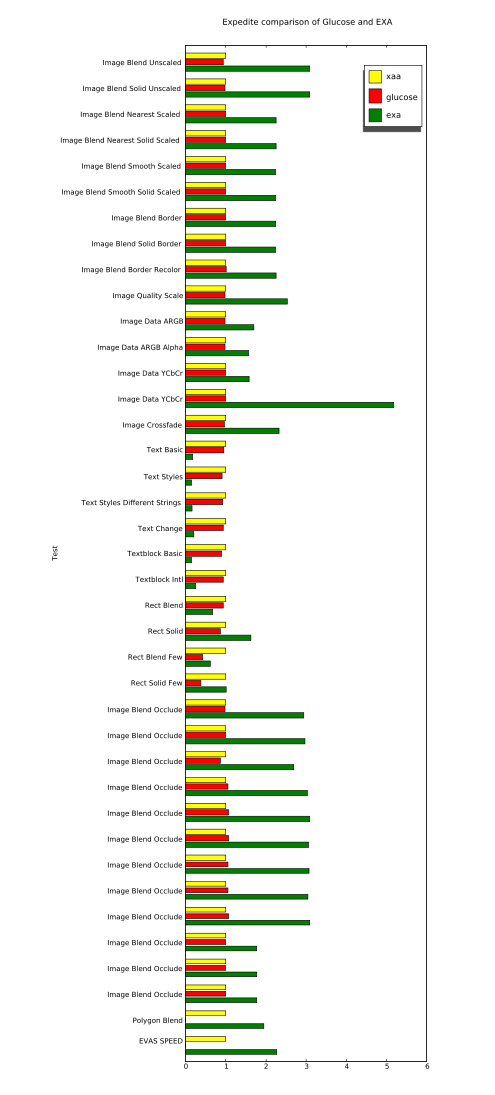As readers of my blog know, I've been working on improving the Intel 965 driver within the EXA acceleration architecture of the X server. Meanwhile, there's an alternate acceleration architecture originally announced by Zack Rusin in August 2006 called Glucose. The idea with Glucose is to accelerate X rendering operations by using OpenGL.
Recently there's been a fair amount of activity in the various Glucose branches, so I thought I'd take a look to see how well it's working. This was quite convenient for me as the current Glucose work is focused only on Intel cards. Since Glucose isn't quite ready for prime-time yet, it does require fetching various non-master branches of several git repositories. It's not always obvious which branches to take, so José Fonseca was kind enough to writeup some Glucose build instructions.
I've followed those instructions and run a benchmark comparing Glucose and EXA. The benchmark I chose is the expedite application that comes with evas, (thanks to the people that kindly pointed out this newer benchmark to me after my recent explorations with the older evas benchmarks). To get expedite you'll need the e17/libs/evas and e17/apps/expedite modules from enlightenment CVS.
Expedite is a nice benchmark in that it separates things like image blending and text rendering into separate tests, (unlike the older evas benchmark). It's also nice that evas includes many backends which can be interesting for comparison. But I won't be looking at anything but its XRender-based backends here---and it looks like evas' cairo and OpenGL backends are not currently functional. They are disabled by default, and when I enabled them I ran into compilation problems, (I suspect neglect and bit rot).
So here are the results I got for three acceleration architectures:
XAA with the XAANoOffscreenPixmaps option, (this is an all-software implementation for reference).
Glucose---the new thing we're looking at here.
EXA, (as available in the various glucose branches---so without things like my recent glyph-pixmaps work).
The results are all normalized to the performance of our baseline, XAA. And larger numbers are better.
The raw data is also available for anyone with particular interest, (it has non-normalized values as well as results from evas' software backends using both SDL and X11 for image transport).
The quick conclusion is that, so far, I'm not getting any benefit from running Glucose as compared to just running an all-software implementation, (see how all Glucose and XAA bars are basically identical). I might still not have everything compiled or running correctly yet, but I'm quite sure that at least some Glucose code was active during my Glucose run. That's because a glucose module failed to find a required symbol and crashed during the "Polygon Blend" test, (which is why it doesn't have a bar in the chart, nor is there a number for the overall "EVAS SPEED" result for Glucose).
Meanwhile, it's also clear that EXA is going far too slow for text operations. This isn't any surprise since I've documented problems with slow text rendering on the i965 several times before. However, I've never before measured text rendering that's quite this slow. I'm seeing speeds of only about 30k glyphs/sec. with EXA on these branches, while my previous testing always showed about 100k glyphs/sec. I suspect that there's been some regression somewhere in the X server or the Intel driver, (and likely unrelated to anything about Glucose---Keith has reported similar slowness with builds from the master branches).
Another interesting thing to look at is the difference caused by the "few" variants of the "Rect Blend" and "Rect Solid" tests. When going from the non-few to the "few" variants, both Glucose and EXA slow down significantly. I'm quite happy to see these tests in this benchmark since it is often the setup overhead that kills you when trying to accelerate a small number of operations, (and applications have a tendency to want to do that very often). Many synthetic benchmarks are extremely non-useful in hiding this overhead by doing huge batches of operations.
Meanwhile, I'm still working on fixing the horribly slow compositing problems in the i965 driver that are keeping text so slow. Keith Packard and Eric Anholt are helping me debug my code, and hopefully we'll soon have something to show which runs at a reasonable speed.

